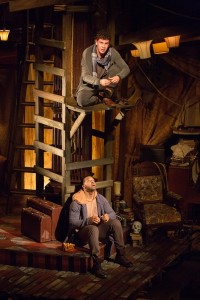Is it Rosencrantz or is it Guildenstern?
I wish I could live inside Tom Stoppard’s mind for an hour. I’d love to know how he comes up with his intricate, cross-referenced plays. One of my favorite quotes of all time comes from an interview Stoppard did with The Paris Review, when the interviewer asked him about the pitfalls of writing.
It is not like playing the violin—not difficult in that way. The difficulties vary at different stages. The first is that you haven’t got anything you wish to write a play about. Then you get an idea, but it might be several ideas that could belong to two or three plays. Finally, if you are lucky, they may fit into the same play. The next difficulty … is to translate these abstract ideas into concrete situations. That is a very long and elaborate period. Another difficulty is knowing when to start; it’s chicken and egg—you don’t know what you’re going to write until you start, and you can’t start until you know. Finally, in some strange, quantum-mechanical way, the two trains arrive on the same line without colliding, and you can begin. The following stage is not exactly pleasant but exciting and absorbing—you live with the fear that “it” may go away. There is a three-month period when I don’t want to say good morning to anyone lest I miss the thought that would make all the difference.
My first introduction to Stoppard was with Rosencrantz and Guildenstern are Dead, which has just opened at The Folger Theatre. (The first play I ever saw at Folger was Stoppard’s Arcadia, also directed by Aaron Posner, so I feel as if I’ve come full circle.) This play – Stoppard’s first, written when he was in his 20s – established the tone for the multi-layered writing that has become his hallmark. It’s a brilliant premise of the two peripheral characters in Hamlet being thrust center stage, and the rest of Shakespeare’s play being treated as a series of out-takes.
Folger’s current production is, once again, pure delight. The back and forth, Godot-like repartee between R&G is always a tour de force, and Adam Wesley Brown and Romell Witherspoon keep the words unflaggingly in the air like a couple of expert jugglers. There is also a tremendous swirl of energy provided by the Player King in the form of Ian Merrill Peakes. I don’t want to give anything away, but there is a moment with the Player Queen (Stephen Russell Murray) that is amongst the funniest, laugh-out-loud moments I’ve ever enjoyed in the theater – another was also on the Folger Stage, when the romantic lead donned a red clown’s nose to play the dog in Two Gentlemen of Verona.
As with all Stoppard’s plays, you really have to keep your wits about you, and it more than pays off. There are so many philosophical threads looping through, to do with time and being and mortality (the word, “dead” is in the title, after all), yet it feels like a romp. And you get to live inside Tom Stoppard’s head for a couple of hours.
Folger Theatre, East Capitol Street, Washington, D.C. until June 21, 2015
Tags:Folger Theatre, Hamlet, Rosencrantz and Guildenstern are Dead, Shakespeare, Tom Stoppard






